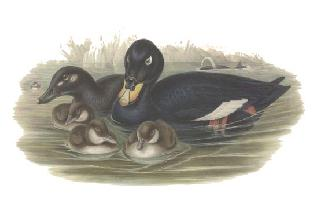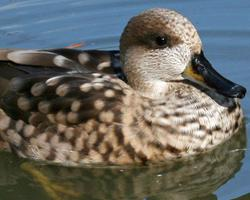
Popis zvířete
The Chestnut Teal (Anas castanea) is a captivating species of dabbling duck native to the southern regions of Australia. This small to medium-sized bird is a marvel of nature, showcasing a unique blend of colors and behaviors that make it a subject of interest among birdwatchers and ornithologists alike.Adult males of the Chestnut Teal species are distinguished by their striking appearance. They possess a glossy green-black head and neck, which contrasts beautifully with their deep chestnut-colored breast and belly. The back and wings are a subtle mix of grey and brown, with the flight feathers being darker. In flight, their green speculum (the panel on the wing) bordered by white is prominently visible, adding to their allure. The male's bill is a dark grey, and their eyes are a penetrating dark brown, adding to their charismatic presence.
Females and juveniles, on the other hand, exhibit a more camouflaged look, which aids in their protection from predators. They are adorned with a mottled brown plumage, which allows them to blend seamlessly into their marshy and coastal habitats. Females also have a green speculum, but it is less vivid than that of the males, and their eyes, legs, and feet share the same coloration as the males, maintaining the species' distinctive characteristics.
Chestnut Teals are primarily found in the coastal and sub-coastal areas of southern Australia, where they inhabit freshwater lakes, swamps, and estuaries. They exhibit remarkable adaptability, being able to thrive in both natural and artificial water bodies. Their diet is omnivorous, consisting of a variety of aquatic vegetation, invertebrates, and at times, small fish, which they forage for by dabbling around the water surface or upending, rather than diving.
One of the most fascinating aspects of the Chestnut Teal is its breeding behavior. They are generally monogamous, forming long-term pair bonds. Nesting typically occurs in dense vegetation near water bodies, where the female lays a clutch of 8-12 creamy-white eggs. The female solely incubates the eggs for about 25-30 days, during which the male remains vigilant in the vicinity of the nest. Once hatched, the ducklings are precocial and able to leave the nest within a day, under the watchful guidance of their mother.
The Chestnut Teal's vocalizations are another interesting characteristic. The males emit a soft, wheezing call, whereas the females are known for their loud, quacking sounds, especially when alarmed or communicating with their ducklings.
Despite facing threats from habitat destruction and pollution, the Chestnut Teal is currently listed as Least Concern by the IUCN, thanks to its broad range and relatively stable population. Conservation efforts and protected areas play a crucial role in ensuring that this enchanting species continues to thrive in its natural habitat.
In conclusion, the Chestnut Teal is a remarkable bird, both in appearance and behavior. Its adaptability to various aquatic environments, coupled with its striking plumage and intriguing life habits, make it a cherished member of the avian world in Australia. Whether observed gliding gracefully over a serene lake or diligently caring for its young, the Chestnut Teal embodies the beauty and resilience of nature.
Podobná zvířata
Nové fotografie zvířat
Top 10 zvířat
- Dolphin gull (Leucophaeus scoresbii)
- Diana monkey (Cercopithecus diana)
- Stone loach (Barbatula barbatula)
- Greek tortoise (Testudo graeca)
- Japanese macaque (Macaca fuscata)
- Moustached guenon (Cercopithecus cephus)
- Galápagos tortoise (Geochelone nigra complex)
- Russian tortoise (Testudo horsfieldii)
- Galápagos penguin (Spheniscus mendiculus)
- Common flying dragon (Draco volans)


